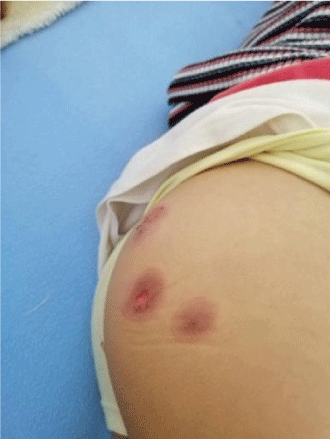Erythema Multiforme Majus Caused by a Double Infection: Mycoplasma Pneumoniae and Herpes Simplex Virus?
Mohamed Sellouti*, Abdelilah Radi, Abdelhakim Ourrai, Amale Hassani, Rachid Abilkassem and Aomar Agadr
Departement of Pediatrics, Mohammed V Military Teaching Hospital, Rabat, Morocco
*Address for Correspondence: Mohamed Sellouti, Departement of Pediatrics, Mohammed V Military Teaching Hospital, Faculty of Medicine and Pharmacy, Rabat, Morocco, Tel : +002-126-606-27466; E-mail: [email protected]
Submitted: 07 July 2019; Approved: 23 July 2019; Published: 25 July 2019
Citation this article: Sellouti M, Radi A, Ourrai A, Hassani A, Abilkassem R, et al. Erythema Multiforme Majus Caused by a Double Infection: Mycoplasma Pneumoniae and Herpes Simplex Virus. Open J Pediatr Neonatal Care. 2019;4(1): 007-009.
Copyright: © 2019 Sellouti M, et al. This is an open access article distributed under the Creative Commons Attribution License, which permits unrestricted use, distribution, and reproduction in any medium, provided the original work is properly cited
Download Fulltext PDF
Erythema Multiforme Majus (EM) is an acute eruptive syndrome, rare in children, and almost non-existent in infants. It can be disabling when associated with severe mucosal involvement. It has a favorable prognosis, but with a significant risk of recurrence. EM is probably an immune response induced by various agents, the most common being Herpes Simplex Virus 1 (HSV1). Other infectious diseases may be involved, in particular Mycoplasma Pneumoniae.
We describe the case of a 6-year-old girl who was hospitalised for generalised skin rash comprising lesions in rings, associated with bullous lesions, essentially oral without genital involvement. The serology of Mycoplasma pneumoniae was positive for IgM at 3191U/ l, IgG at 885U/ l, and the serology of HSV was positive for IgM at 120U/l and IgG at 84.3U/ l.
The evolution was favorable in a few days following administration of symptomatic treatment (rehydration, mouthwash) and etiological treatment (acyclovir: 500 mg / m² / day and erythromycin 50mg / kg/ day).
The diagnosis of EM secondary to dual infection with Mycoplasma pneumoniae and HSV has never been reported in the literature.
Introduction
EM of infectious origin is an acute eruptive syndrome defined by the morphology of the lesions, occurring rather in the young subject. It was first described in 1870 by Von Hebra [1]. EM is probably an immune response induced by various infectious agents, the most common being HSV1. Other infectious agents may be involved, in particular Hepatitis B and C, Mycoplasma pneumoniae and Parvovirus B19. Drug causes are rare. We report an original case of EM with concurrent infection with Mycoplasma pneumoniae and HSV1.
Case Report
A 6-year-old girl admitted to our service for difuse pruritic skin rashes. Seven days earlier, she had an upper respiratory tract infection treated symptomatically with carbocysteine. Two days before admission there were painful erosions of the oral mucosa making feeding very difficult.
The physical examination found a febrile child at 38.6°, well oriented, pulse was 88 per min, blood pressure was 100/50 and the respiratory rate was 18 per minute. The oral mucosa was covered by painful, extensive polycyclic erosions with a yellowish coating (Figure 1).
The lesions in rings are a regular and rounded form placed on the face, the dorsal surface of the hands, the palms, and over her four limbs (Figure 2). Other physical findings were unremarkable.
Biological assays showed hyperleukocytosis at 12203/ mm3 (61% lymphocytes and neutrophils at 39%), hemoglobin at 9.6g/ dl, VGM at 70.2 μ3, MHC at 21.9 pg, MCHC at 31,9%, and a platelet count at 344103/ mm3. C-reactive protein level was 1.16 mg/ l. The blood cultures performed were negative. Chest X-ray did not indicate an infectious focus.
Serological testing for Mycoplasma pneumoniae was positive with IgM of 3191U/ ml (normal values ≤ 770U/ ml) and IgG of 885U/ ml (normal values ≤ 200U/ ml), and the serology of the HSV 1 was positive with IgM of 120U/ ml (normal values ≤ 22U/ ml) and IgG of 84.3U/ml (normal values ≤ 14U/ ml). Serologies to Epstein-Barr virus, Cytomegalovirus, Hepatitis B and C virus, Human immunodeficiency virus, Parvovirus B19, were negative, antibodies all negative.
The diagnosis of EM suggested to double infection with Herpes and Mycoplasma pneumoniae. She was treated symptomatically by (intravenous rehydration, and mouthwashes), and aetiological treatment with acyclovir (500 mg/ m²/ d intravenously) to HSV and Josamycin (50 mg / kg / d, oral) continued for 15 days to Mycoplasma pneumoniae.
The outcome was favorable in a few days with resumption of feeding, cicatrization mucosal lesions and then cutaneous in 2 weeks.
The different serologies were recontrolled at 15 days: Mycoplasma pneumoniae was positive with IgM of 5128 UI and IgG of 2456 IU; HSV was positive with IgM of 640UI and IgG at 256UI.
Discussion
Many authors placed EM in the same nosological spectrum as Stevens-Johnson syndrome and Lyell’s syndrome. However, in recent years, this concept has been totally questioned. Recent studies suggest that EM and Stevens-Johnson syndrome clinically and etiologically represent different diseases. While Stevens-Johnson syndrome is usually drug-induced, the majority of cases of EM are triggered by infections, with predominant mucous membrane involvement especially HSV and Mycoplasma pneumoniae play a role [2,3].
EM most often affects young adults (average age between 25 and 30 years) and usually begins with an acute Influenza-like illness. Cutaneous and mucosal involvement is characteristic. The mucosal lesions in rings, associated with bullous and post-bullous lesions precede the cutaneous involvement, coin-sized annular erythemas with central dusky red areas. EM is caused by HSV in about half of the cases. Herpes is the most incriminated infectious agent in recurrent EM flare [4]. It therefore seems important during a EM flare to search for the presence of HSV by serological study or by PCR on a biopsy of the cutaneous lesions
Mycoplasma pneumoniae is the second etiological agent founded, mainly in the major forms of EM (responsible for 5% cases) [5].
Chlamydia pneumoniae is responsible for respiratory infections in humans. Seroprevalence is low before 5 years, it increases gradually to reach 50% in the adult [6]. Infection predominates in young adult males and in urban areas. This germ can also be responsible for other dermatological manifestations: cases of erythema nodosum, hypersensitivity syndrome and Sweet’s syndrome have been described [6,7].
Other viruses or bacteria are sometimes implicated (Hepatitis B and C, Yersiniosis, Rickettsiosis, Tularemia, Tuberculosis, Parvovirus B19 and Cytomegalovirus).
The pathophysiologic mechanism of EM is not known. Currently, EM is considered to be a cellular reaction to viral antigens present in the epidermis [8].
In this case, Chlamydia pneumoniae and HSV were very probably responsible for EM. However, despite the elevation of IgG to four times the initial rate, the interpretation of serologies remains delicate because there has been no real seroconversion
It has never been described, to our knowledge, EM caused by a double infection with Mycoplasma pneumoniae and HSV. However, we have found in the literature an observation of two cases of EM induced by a double infection with Mycoplasma and Chlamydia pneumoniae, without it being possible to determine the responsibility of each germ [9]. The clinician should discuss the responsibility for these two germs when they are demonstrated by reliable techniques and that the search for other infectious agents usually found is negative.
Conclusion
This original case illustrates co-infection Mycoplasma pneumoniae and HSV. These two germs are responsible for more than 80% of EM. This etiological diagnosis makes it possible to adapt the treatment and to take care of the patient more effectively.
- Hebra V. Atlas der Hautkrankenheiten. Wien: Kaiserliche Akademie der Wissenschaften. 1866.
- Assier H, Bastuji-Garin S, Revuz J, Roujeau JC. Erythema multiforme with mucous membrane involvement and Stevens-Johnson syndrome are clinically different disorders with distinct causes. Arch Dermatol. 1995; 131: 539-543. https://bit.ly/30JL9gM
- Bastuji-Garin S, Rzany B, Stern RS, Shear NH, Naldi L, Roujeau JC. Clinical classification of cases of toxic epidermal necrolysis, Stevens-Johnson syndrome and erythema multiforme. Arch Dermatol. 1993; 129: 92-96. https://bit.ly/2M8BNHt
- Ting HC, Adam BA. Erythema multiform: epidemiology, clinical characteristics and natural history of fifty-nine patients. Aust J Dermatol. 1984; 25: 83-88. https://bit.ly/2XYwqlq
- Maleville J, Massicot P, Ponge A, Guillard JM, Sarrat P, Guillet G. Aspects clinique et étiologique de l’érythème polymorphe. À propos de 40 observations. Sem Hop Paris. 1983; 59: 671-675.
- Gaillat J. Manifestations cliniques des infections à Chlamydia pneumoniae. Rev Med Interne 1996; 17: 41S-44S.
- Rubegni P, Marano MR, de Aloe G, Pianigiani E, Bilenchi R, Fimiani M. Sweet’s syndrome and Chlamydia pneumoniae infection. J Am Acad Dermatol. 2001; 44: 862-864. https://bit.ly/2XRLtNA
- Orton PW, Huff JC, Tonnesen MG, Weston WL. Detection of a herpes simplex viral antigen in skin lesions of erythema multiforme. Ann Intern Med. 1984; 101: 48-50. https://bit.ly/2y3towI
- Terada K, Hiraga Y, Mori R, Yagi-Shimada Y, Kawano S, Kataoka N. Double infection of Chlamydia pneumoniae and Mycoplasma pneumoniae in children. Kansenshogaku Zasshi. 1996; 70: 1176-1180. https://bit.ly/32IjcYQ



Sign up for Article Alerts